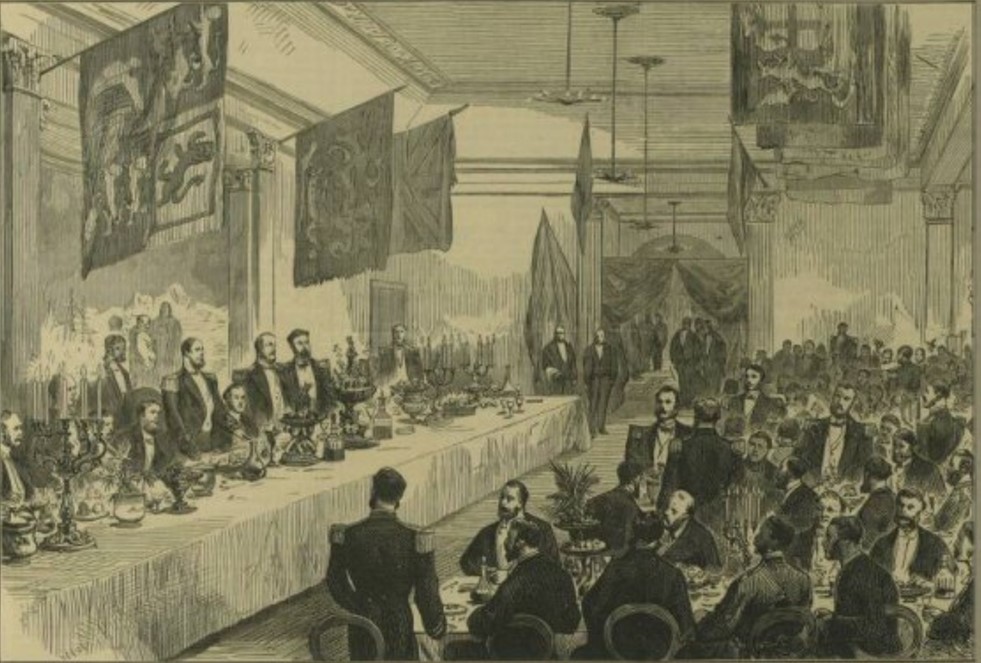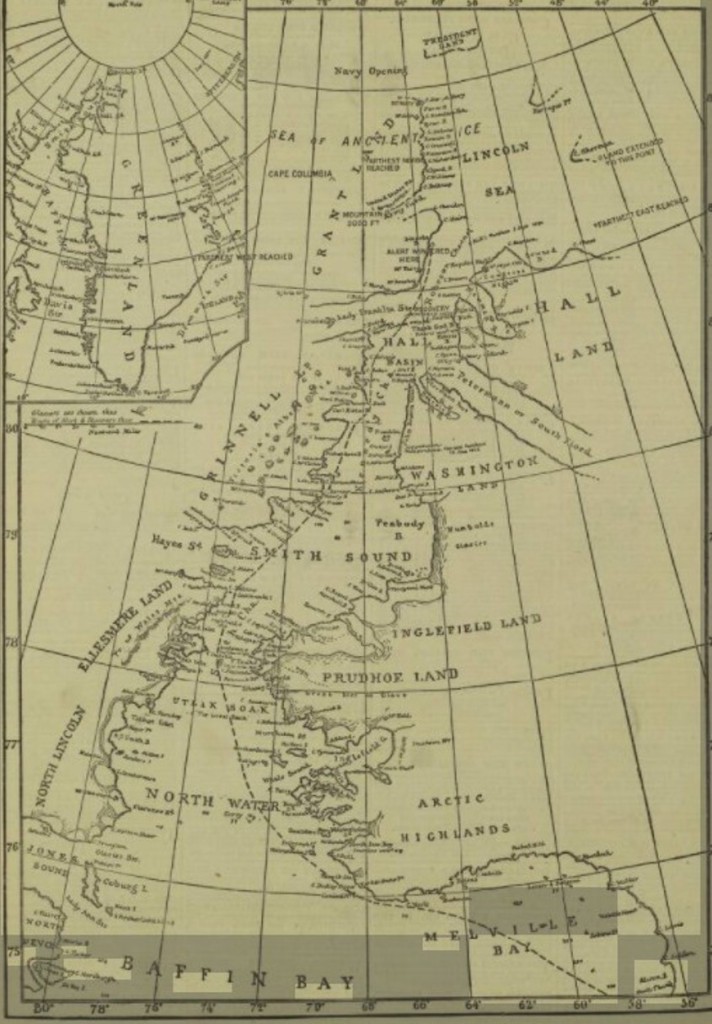Voyage of Discovery - part 1
May 29th 1875, the official birthday of Queen Victoria, was a day of huge national importance. Excitement had increased over many months and now, the anticipation of spectacular success even more assured with the realisation that departure was coinciding with Oak Apple Day, the traditional day of celebrating the Restoration of King Charles II [see footnote i] to the throne. It seemed that the world had descended on Portsmouth, Britain’s premier Naval town to witness the sailing of Her Majesty’s Ships, the HMS Alert and HMS Discovery for the Arctic, and indeed it had.

The interest of the Monarchy in the ships preparation for travel had culminated with a visit from the Ex-Empress Eugenie [Bonaparte] and her son, the Prince Regent on the 22nd. There they had greeted the men who would be sailing the following Saturday. Once the Royal party had left, the sailors marched through the town led by bandsmen to Portland Hall, Southsea, where the Mayor entertained them to dinner. The hall, which had hosted the Officers two days earlier had been decorated with models of the ships complete with icebergs and banners. After dinner, Captain Nares of the Alert, and leader of the expedition, made an appearance to “thunderous applause”, followed by many of the men’s wives who were entertained at a separate table.

Amongst the diners that day was John Langston Saggers, who for the past few months had been serving on Queen Victoria’s Royal Yacht, the HMY Osborne. He had joined the Navy five years earlier and his record had been exemplary from the start. Perhaps of greater importance, he was well within the criteria to be aboard the Arctic Expedition ships: at 5’ 4” (163cm) tall he was five inches below the maximum height and he had the fair complexion common to almost all those on board, a feature noted by newspapers eager to report on every facet of the trip. Single and aged just 22 years old, he was about to embark on an adventure unlike any other – the quest to reach the North Pole before other competing nations.

Attempts to reach the Pole in the past had always ended in failure with ships and crew either being lost at sea or unable to find a passage through the ice. A belief held by many was that, if a way through could be found, the Pole may be the centre of a land with a benign climate where plants and animals flourished and potential minerals could be mined. After all, they argued, had this not happened before with the discovery of the Americas? This seems such an extraordinary thought in our now enlightened times that the full text can be read in footnote ii.

By Friday 28th, the men were on duty and only essential non-crew allowed aboard. Of particular concern were the “Welch and Boucher’s Portable Lifebouys” – life rafts that had a central sealed food reservoir, the rations being sucked up through flexible feeding tubes. They were also fitted with lanterns so that, at night, any man overboard could (as they assumed) swim to safety. These and hundreds of other items were carefully checked and tested. Ex-Empress Eugenie had been especially concerned about the men having adequate warm clothing and had made, for each man, “comfortable, woollen-knitted wigs” for which the Expedition was “indebted.”

On the 29th, the departure ceremonies started early in the day. The Royal Standard was raised and the men and officers all wore sprays of oak leaves in their button-holes as an expression of their loyalty. Every ship in the dockyard was dressed from stern to stern with their signal flags, all fluttering in the gentle north-westerly breeze. The Alert and the Discovery, ready to depart, differed from the other ships by only hoisting the St George ensign. Piped aboard, the Lord Admirals of the Fleet carried out their final inspection before shaking hands with each of the Officers. As they left, Mr George Ward Hunt, First Lord of the Admiralty, turned to acknowledge the crew before saying quite simply, “Good-bye, men” to which they responded with loud and excited cheering.

On Southsea Common a long line of field guns and troops from the Royal Engineers, the Royal Artillery and other regiments stood facing seawards. The massed bands became silent at 11.30 and soon after, the first deafening volley of gun salutes echoed across the water to be answered by volleys from the ships and three other places along the coast. The ceremony concluded with a march past of the massed troops reported with patriotic zeal, “…the perfection of precision for which British troops are so remarkable.”

On the beach and pier, thousands of well-wishers gathered to see the boats depart. They had travelled from all over Britain with special trains being laid on for the occasion. Wives and “sweethearts” of the crew were allowed into the dockyard and crowded onto the piers. Amongst them, and consoling them, were the wives of Scottish trawlermen who fished close to the Arctic ice; their reassurances belying the dangers and losses that they sometimes endured. On board, Captain Nares read out a telegram from the Queen: “I earnestly wish you and your gallant companions every success, and I trust that you may safely accomplish the important duty you have so bravely undertaken.” The Queen also sent aboard two large parcels, one for each ship, with the order that they were only to be opened at sea. I have yet to discover what they may have held.

The time had come to depart, the Alert being the first to leave, followed by the Discovery. Escorting them were flotillas of ships and smaller craft as well as excursion steamers carrying passengers, all bedecked with flags. From the thousands of spectators onshore and from those on the small boats came cheer after cheer and shouts of “God speed” to be answered with cheering from the crew of both ships. The newspapers noted that “…four hundred miles – as far as from London to Edinburgh only – is all that stands between him [Captain Nares] and Arctic immortality. Every Englishman will devoutly pray that he may secure it, and return safe and sound.”
I discovered the intriguing story of the Arctic Expedition when researching the life of John Langston Saggers, my ancestral 1st cousin. The outcome of the Arctic Expedition, the fate of the Alert and Discovery, and that of John Langston Saggers will follow shortly in my next post. Edit: This is now published and can be found by clicking this link.

Footnote i. Oak Apple Day, also known as Restoration Day or Royal Oak Day, commemorates the day in 1660 when King Charles II returned from Exile to be restored to the British throne. He had fled to Europe following the execution of his father, Charles I during the English Civil War. Why an oak to commemorate the day? It was said that he alluded capture by hiding in an oak tree. The tradition of wearing oak leaves has mostly died out but there are several villages in England where local ceremonies still take place.
Footnote ii. “…the flora of Greenland has three hundred flowering plants. What may not that of the North Pole number?” “ …within 400 miles of the Pole man, Esquimaux [sic], has been found. [May not} a race be found uncontaminated by the vices of the known world, and yet with some of its ingenuity? …May we not find some ‘Arcadian Retreats,’ some ‘Happy Valleys,’ or perhaps the ‘Lost Ten Tribes?…’
Sources
Ancestry UK
Royal Navy Registers of Seamen’s Services 1848-1939
British Newspaper Archive: The Morpeth Herald, The Derby Mercury, The Standard, The Nuneaton Advertiser, The Illustrated London News
Wikipedia
Comments
Post a Comment